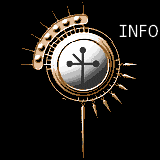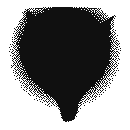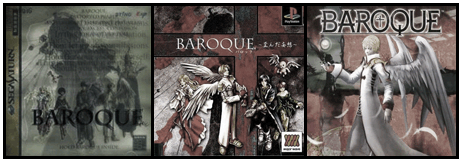
Generational Decay
Baroque has had three major releases: "Baroque" for the Sega Saturn in 1998, "Baroque ~Distorted Delusions~" for the Sony Playstation in 1999, and "Baroque International" for the Sony Playstation 2 and Nintendo Wii in 2007. The latter two versions are often assumed to be the definitive versions, but this is a misconception based on the relative obscurity of the Sega Saturn original.
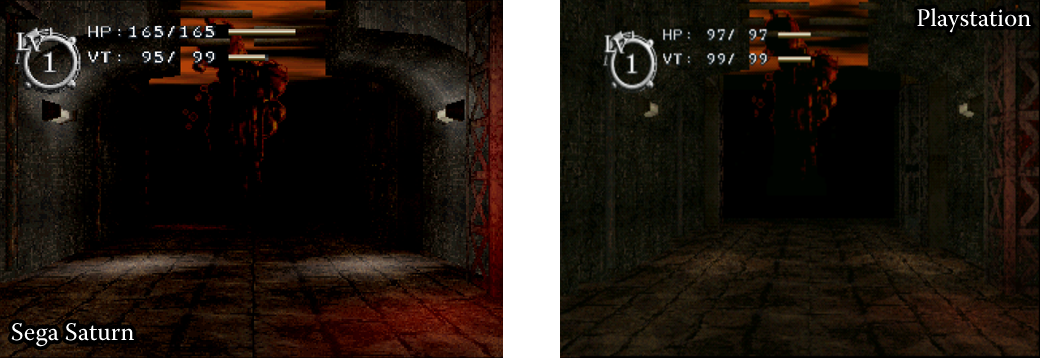
The initial port of the game, "Baroque ~Distorted Delusions~" makes some considerable changes - almost entirely to the detriment of the game. Whether the development team wasn’t given enough time to fully convert all of the code over from the Saturn’s esoteric architecture or they were simply exhausted from years of painstaking work on the original, the port ended up being a much weaker experience than its Sega Saturn progenitor. Baroque’s writer and director, Kazunari Yonemitsu, has an incredible eye for detail and he seems to be the kind of director that wants to include tons of little facets that give the game’s world an incredible sense of depth and life. Unfortunately, this seems to have created a large amount of elements that simply weren’t possible to carry over to the Playstation with the limited resources they were allotted for the task.
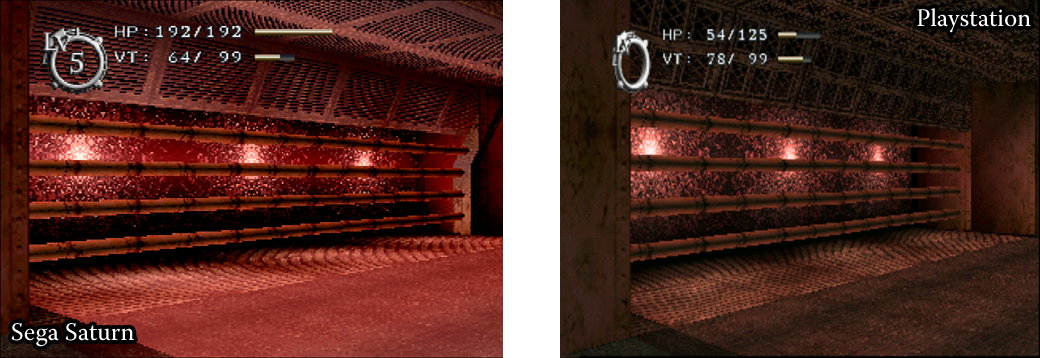
The most striking change in the Playstation version is the total loss of the film noir aesthetic the original game was conceived around. Instead of stark contrast, heavy use of shadows, and bold lighting, the PS1 port settles for murky, uniform lighting with little contrast. The heavy use of red and black in the original has been replaced by a sickly green that permeates everything, which spoils the original’s gorgeous atmospheric lighting. The characters and Grotesques have also received noticeable downgrades, with sprites being stretched considerably. Even worse, several animations are flat out missing, such as the Hungones' swaying as it moves across the ceiling. Gone too are a huge number of sound effects and ambient noise that added variety and flavor to the soundscape of the Nerve Tower. The music transitions have been cut entirely, so tracks now just abruptly halt at the end of a floor. Widescreen support has also been dropped.
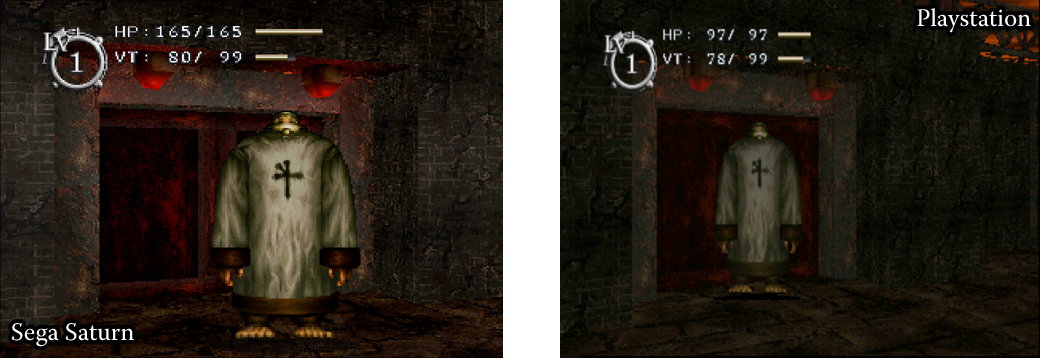
A couple of new features have been added in order to compensate for the port's quality, but most of them serve only to detract from the original's charm. The enjoyment of discovering additional dialogue lines exclusive to the PS1 port is cut short when you realize that random lines of dialogue have been added to a "Scene List" that demands the player trigger nearly 250 lines of arbitrarily selected dialogue with NPCs in order to unlock material already available on the "Baroque Report CD Data File". This leads to hours of endlessly attempting various combinations to try and get NPCs to say the right thing - a frustrating endeavor that sucks the joy out of the unique sense of discovery inherent in Baroque. Worse still, several lines you have to unlock early on are bugged, making them permanently missable - silently ruining your collection in a way you won't discover until it's too late. While there are a few excellent new additions to the script, the majority of the new dialogue lines are pretty dire. These range from edgy dramatics to tasteless dad jokes which only serve to cheapen the game's atmosphere. But the biggest victim of the script revisions is the Archangel, whose motivations were changed from ‘wanting to eradicate distorted people/thoughts from the world’ into ‘wanting to screw up the world so badly that people stop ignoring distorted (ie disabled) people’ in order to avenge his disfigured sister (a new character borrowed from a work of fanfiction). This change substantially clashes with pre-existing dialogue and convolutes the game’s central message.

In addition, you can collect the hundreds of items in the game, transferring them one at a time through the Sense Spheres in a painstaking and completely mindless scavenger hunt. Even worse, the floor count of the Nerve Tower has been considerably padded out, so now every trip takes far longer than I personally prefer. Other changes include a new NPC that stores your items (allowing you to endlessly farm upgrade materials to create ridiculously overpowered gear), and a post-game "Hell Dungeon" which is so absurdly artificially difficult that the game's creator admits to having never beaten it. That said, I want to apologize for previously claiming that farming +99 gear was the only way to beat this challenge dungeon. I recently managed to beat the Hell Dungeon without taking any items in with me, and I have to admit that it was an incredibly rewarding experience that forced me to master and use every game mechanic in order to survive.
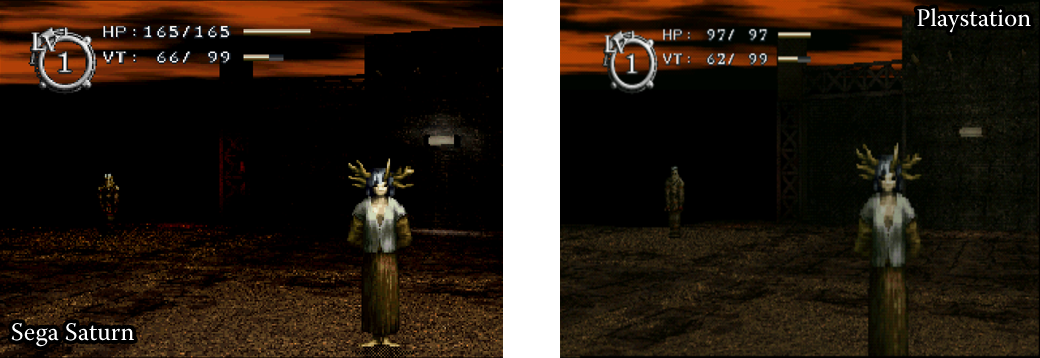
After the PS1 port, Sting made three more games with the Baroque IP. The first was a Baroque-themed reskin of Sting’s typing software (“Yuka Typing”). Because these two titles are virtually identical, cross-play between the two games was possible over the internet. To make matches fair, both clients had to be using the same set of dialogue to type out. This often led to the cutesy shoujo-manga characters of Yuka Typing saying the weird and disturbing dialogue of Baroque characters. Sting also released the vertical scrolling shooter “Baroque Shooting”, which started out as a self-published fangame. Both are perfectly competent games but neither are particularly remarkable. On the other hand, "Baroque Syndrome" (Sting's extremely poor attempt to copy-paste Mariko Shimizu’s Baroque prequel stories into visual novel format) was awful. The player is given almost no meaningful choices, the small amount of new (ghostwritten) content is terrible, and it massively contradicts both the source material and Baroque. Read more about it here.
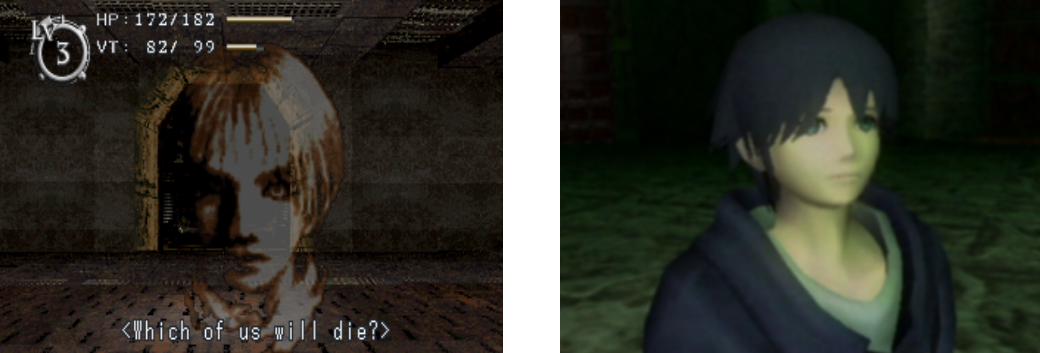
In 2007, "Baroque International" hit shelves and remains the only version of Baroque most people have played. It disastrously repeats all the sins of the PS1 port, further removing visual contrast while adding additional pointless collectathons and tedious challenge dungeons. The tedium is unavoidable this time around, as the pacing of the non-optional content has also been massively reduced. The Nerve Tower's floor count has been more than doubled, the new third person perspective forces the player to sit through slow and floaty animations before they can perform their next action (killing rapid item use strategies), and nearly every Grotesque has been given a new and obnoxious ailment-inducing attack. All of these decisions turn the once nail-biting dash through the sanctuary into an absolute chore.
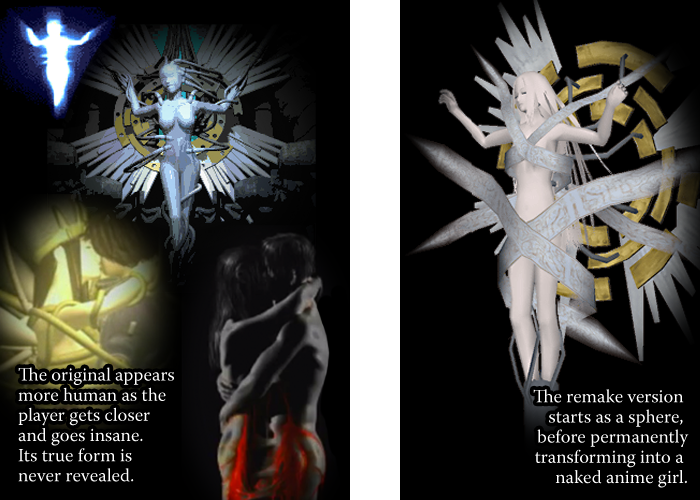
The gameplay suffers from these changes, but the aesthetic of the original game is obliterated completely. The remake’s decision to double down on the bland anime aesthetic of the original game’s promotional art transforms the Gigeresque original into an utter embarrassment. To better fit the uninspired, “Kingdom Hearts”-esque visuals, the script has been censored to remove most instances of the words “die” or “kill” - replacing them with 4Kids approved terms like “vanish” or “erase”. This censorship takes lines such as "My father tried to kill me. Are you trying to kill yourself?" and mangles them into nonsense like "My father tried to lay hands on me, are you trying to erase yourself?" The censorship is present even in the original Japanese version of the remake - it was not a decision made by Atlus USA during localization. Yonemitsu’s adamant directions about the soundtrack “not being music” have been thrown out the window entirely; the player now treated to repetitive techno as they trudge through the Nerve Tower’s hugely inflated floor count. The story has been altered in contradictory and detrimental ways as to incorporate the awful “Baroque Syndrome” visual novel and changes made in Baroque’s manga adaptation. Besides the ability to tear Eliza and Alice away from God once more in the post-game, the most glaring example of this is the inclusion of Kitsune Kanazawa (the “Baroque Salesman”) as a new NPC. Disregarding the fact that all NPCs are perfectly capable of reading Idea Sefirot on their own - and the fact that Kitsune is supposed to be a scam artist with no special powers - the remake pretends he has the mystical ability to ascertain the true contents of these crystals. There's also some nonsense about the Horned Woman's "true identity" being a character from "Syndrome". These inclusions are purely fanservice over integrity - a design philosophy that summarizes most of the remake's awful design choices.
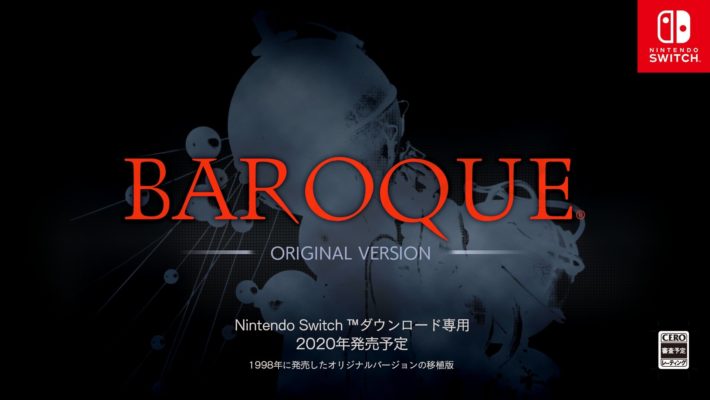
Following the remake, Sting would continue to milk the Baroque IP in the form of early mobile games - the majority of which appear to have been lost forever. However, they completely and unexpectedly reversed course on November 12th, 2020 when the company released a faithful port of the original Saturn version for the Nintendo Switch. This is nearly a perfect port, with only some control stiffness and small graphical glitches during a few FMV sequences. However, the lag that cropped up on the Sega Saturn during hectic fights has been completely removed. This port also includes several extras, including the Baroque Report CD Data File for the Sega Saturn. As long as you're willing to put up with the sub-par controls, this is currently the best and most accurate way to experience the definitive version of Baroque (unless you have the cash to drop on a Saturn, 3D Control Pad, and a CRT).
